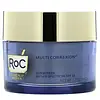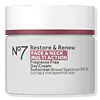RoC Multi Correxion Neck & Face Cream SPF 30 Versus No7 Restore & Renew Face & Neck Multi Action Cream SPF 30
What's inside
What's inside
 Key Ingredients
Key Ingredients

 Benefits
Benefits

 Concerns
Concerns

 Ingredients Side-by-side
Ingredients Side-by-side

Water
Skin ConditioningPropylene Glycol
HumectantGlycerin
HumectantIsononyl Isononanoate
EmollientDimethicone
EmollientSteareth-2
EmulsifyingEthylhexyl Palmitate
EmollientStyrene
PerfumingButyrospermum Parkii Butter
Skin ConditioningVinyl Dimethicone/Methicone Silsesquioxane Crosspolymer 2%
Butyl Methoxydibenzoylmethane
UV AbsorberHomosalate 4%
Skin ConditioningOctocrylene 4%
UV AbsorberBenzophenone-3 2%
UV AbsorberHexylresorcinol
AntimicrobialSteareth-21
CleansingPeucedanum Graveolens Extract
TonicRubus Fruticosus Leaf Extract
MaskingTocopheryl Acetate
AntioxidantAscorbyl Glucoside
AntioxidantSclerotium Gum
Emulsion StabilisingStearyl Alcohol
EmollientPEG-8 Laurate
EmulsifyingAcrylates Copolymer
Ammonium Acryloyldimethyltaurate/Vp Copolymer
Behenyl Alcohol
EmollientArachidyl Alcohol
EmollientMaltodextrin
AbsorbentXanthan Gum
EmulsifyingLinseed Acid
CleansingDimethicone Crosspolymer
Emulsion StabilisingCetyl Alcohol
EmollientButylene Glycol
HumectantSodium Dodecylbenzenesulfonate
CleansingPhenoxyethanol
PreservativeChlorphenesin
AntimicrobialSodium Carbonate
BufferingSodium Hydroxide
BufferingDisodium EDTA
Ethylhexylglycerin
Skin ConditioningParfum
MaskingWater, Propylene Glycol, Glycerin, Isononyl Isononanoate, Dimethicone, Steareth-2, Ethylhexyl Palmitate, Styrene, Butyrospermum Parkii Butter, Vinyl Dimethicone/Methicone Silsesquioxane Crosspolymer 2%, Butyl Methoxydibenzoylmethane, Homosalate 4%, Octocrylene 4%, Benzophenone-3 2%, Hexylresorcinol, Steareth-21, Peucedanum Graveolens Extract, Rubus Fruticosus Leaf Extract, Tocopheryl Acetate, Ascorbyl Glucoside, Sclerotium Gum, Stearyl Alcohol, PEG-8 Laurate, Acrylates Copolymer, Ammonium Acryloyldimethyltaurate/Vp Copolymer, Behenyl Alcohol, Arachidyl Alcohol, Maltodextrin, Xanthan Gum, Linseed Acid, Dimethicone Crosspolymer, Cetyl Alcohol, Butylene Glycol, Sodium Dodecylbenzenesulfonate, Phenoxyethanol, Chlorphenesin, Sodium Carbonate, Sodium Hydroxide, Disodium EDTA, Ethylhexylglycerin, Parfum
Butyl Methoxydibenzoylmethane 3%
UV AbsorberEthylhexyl Salicylate 5%
UV AbsorberOctocrylene 8%
UV AbsorberWater
Skin ConditioningC12-15 Alkyl Benzoate
AntimicrobialGlycerin
HumectantAlcohol Denat.
AntimicrobialTribehenin
EmollientButylene Glycol
HumectantAluminum Starch Octenylsuccinate
AbsorbentDimethicone
EmollientCetearyl Alcohol
EmollientButyrospermum Parkii Butter
Skin ConditioningAmmonium Acryloyldimethyltaurate/Vp Copolymer
Cetearyl Glucoside
EmulsifyingSilica
AbrasivePhenoxyethanol
PreservativePotassium Cetyl Phosphate
EmulsifyingMethylparaben
PreservativeTocopheryl Acetate
AntioxidantDimethiconol
EmollientPentylene Glycol
Skin ConditioningAscorbyl Glucoside
AntioxidantPropylene Glycol
HumectantXanthan Gum
EmulsifyingEthylparaben
PreservativeHibiscus Abelmoschus Extract
MaskingRetinyl Palmitate
Skin ConditioningSimethicone
EmollientHydrolyzed Hyaluronic Acid
HumectantTetrasodium EDTA
Cetyl Alcohol
EmollientStearyl Alcohol
EmollientHydrolyzed Rice Protein
Skin ConditioningSorbitan Laurate
EmulsifyingPolysorbate 20
EmulsifyingT-Butyl Alcohol
PerfumingPanax Ginseng Root Extract
EmollientSodium Lauroyl Lactylate
EmulsifyingPhyllanthus Emblica Fruit Extract
HumectantCarbomer
Emulsion StabilisingCalcium Hydroxymethionine
Skin Conditioning3-Aminopropane Sulfonic Acid
Hydroxyethylcellulose
Emulsion StabilisingPotassium Hydroxide
BufferingDimethylmethoxy Chromanol
AntioxidantAcetyl Dipeptide-1 Cetyl Ester
Skin ConditioningMorus Alba Leaf Extract
Skin ConditioningCeramide NP
Skin ConditioningCeramide AP
Skin ConditioningSodium Benzoate
MaskingPhytosphingosine
Skin ConditioningCholesterol
EmollientEthylhexylglycerin
Skin ConditioningTocopherol
AntioxidantPalmitoyl Tripeptide-1
Skin ConditioningPalmitoyl Tetrapeptide-7
Skin ConditioningCeramide EOP
Skin ConditioningCI 77891
Cosmetic ColorantCI 77491
Cosmetic ColorantCI 14700
Cosmetic ColorantButyl Methoxydibenzoylmethane 3%, Ethylhexyl Salicylate 5%, Octocrylene 8%, Water, C12-15 Alkyl Benzoate, Glycerin, Alcohol Denat., Tribehenin, Butylene Glycol, Aluminum Starch Octenylsuccinate, Dimethicone, Cetearyl Alcohol, Butyrospermum Parkii Butter, Ammonium Acryloyldimethyltaurate/Vp Copolymer, Cetearyl Glucoside, Silica, Phenoxyethanol, Potassium Cetyl Phosphate, Methylparaben, Tocopheryl Acetate, Dimethiconol, Pentylene Glycol, Ascorbyl Glucoside, Propylene Glycol, Xanthan Gum, Ethylparaben, Hibiscus Abelmoschus Extract, Retinyl Palmitate, Simethicone, Hydrolyzed Hyaluronic Acid, Tetrasodium EDTA, Cetyl Alcohol, Stearyl Alcohol, Hydrolyzed Rice Protein, Sorbitan Laurate, Polysorbate 20, T-Butyl Alcohol, Panax Ginseng Root Extract, Sodium Lauroyl Lactylate, Phyllanthus Emblica Fruit Extract, Carbomer, Calcium Hydroxymethionine, 3-Aminopropane Sulfonic Acid, Hydroxyethylcellulose, Potassium Hydroxide, Dimethylmethoxy Chromanol, Acetyl Dipeptide-1 Cetyl Ester, Morus Alba Leaf Extract, Ceramide NP, Ceramide AP, Sodium Benzoate, Phytosphingosine, Cholesterol, Ethylhexylglycerin, Tocopherol, Palmitoyl Tripeptide-1, Palmitoyl Tetrapeptide-7, Ceramide EOP, CI 77891, CI 77491, CI 14700
 Reviews
Reviews

Ingredients Explained
These ingredients are found in both products.
Ingredients higher up in an ingredient list are typically present in a larger amount.
Ammonium Acryloyldimethyltaurate/Vp Copolymer (let's call it AAVC for short) is a synthetically created polymer. It's used as a film-forming agent and used to thicken the consistency of products.
AAVC is able to increase the consistency and viscosity of products due to its large molecule size. It also prevents ingredients from separating.
Ascorbyl Glucoside is a stable form of Vitamin C. It is created by combining glucose from starch.
When applied to skin, Ascorbyl Glucoside turns into Ascorbic Acid.
Ascorbyl Glucoside is an antioxidant. Antioxidants help fight free-radicals, or molecules that may damage skin cells.
It can help to reduce redness, improve skin texture, reduce the effects of aging, reduce the visibility of dark spots, and brighten skin.
Read more about other types of Vitamin C:
Learn more about Ascorbyl GlucosideAlso known as Avobenzone, this ingredient is a chemical sunscreen filter that provides protection in the UV-A range.
Avobenzone is globally approved and is the most commonly used UV-A filter in the world.
Studies have found that avobenzone becomes ineffective when exposed to UV light (it is not photostable; meaning that it breaks down in sunlight). Because of this, formulations that include avobenzone will usually contain stabilizers such as octocrylene.
However, some modern formulations (looking at you, EU!) are able to stabilize avobenzone by coating the molecules.
Avobenzone does not protect against the UV-B range, so it's important to check that the sunscreen you're using contains other UV filters that do!
The highest concentration of avobenzone permitted is 3% in the US, and 5% in the EU.
Learn more about Butyl MethoxydibenzoylmethaneButylene Glycol (or BG) is used within cosmetic products for a few different reasons:
Overall, Butylene Glycol is a safe and well-rounded ingredient that works well with other ingredients.
Though this ingredient works well with most skin types, some people with sensitive skin may experience a reaction such as allergic rashes, closed comedones, or itchiness.
Learn more about Butylene GlycolThis ingredient is also known as shea butter. It is an effective skin hydrator and emollient.
Emollients help soothe and soften your skin. It does this by creating a protective film on your skin. This barrier helps trap moisture and keeps your skin hydrated. Emollients may be effective at treating dry or itchy skin.
Shea butter is rich in antioxidants. Antioxidants help fight free-radicals, or molecules that may harm the body. It is also full of fatty acids including stearic acid and linoleic acid. These acids help replenish the skin and keep skin moisturized.
While Shea Butter has an SPF rating of about 3-4, it is not a sunscreen replacement.
Shea butter may not be fungal acne safe. We recommend speaking with a professional if you have any concerns.
Learn more about Butyrospermum Parkii ButterCetyl Alcohol is a fatty alcohol. Fatty Alcohols are most often used as an emollient or to thicken a product.
Its main roles are:
Though it has "alcohol" in the name, it is not related to denatured alcohol or ethyl alcohol.
The FDA allows products labeled "alcohol-free" to have fatty alcohols.
Learn more about Cetyl AlcoholDimethicone is a type of synthetic silicone created from natural materials such as quartz.
What it does:
Dimethicone comes in different viscosities:
Depending on the viscosity, dimethicone has different properties.
Ingredients lists don't always show which type is used, so we recommend reaching out to the brand if you have questions about the viscosity.
This ingredient is unlikely to cause irritation because it does not get absorbed into skin. However, people with silicone allergies should be careful about using this ingredient.
Note: Dimethicone may contribute to pilling. This is because it is not oil or water soluble, so pilling may occur when layered with products. When mixed with heavy oils in a formula, the outcome is also quite greasy.
Learn more about DimethiconeEthylhexylglycerin (we can't pronounce this either) is commonly used as a preservative and skin softener. It is derived from glyceryl.
You might see Ethylhexylglycerin often paired with other preservatives such as phenoxyethanol. Ethylhexylglycerin has been found to increase the effectiveness of these other preservatives.
Glycerin is already naturally found in your skin. It helps moisturize and protect your skin.
A study from 2016 found glycerin to be more effective as a humectant than AHAs and hyaluronic acid.
As a humectant, it helps the skin stay hydrated by pulling moisture to your skin. The low molecular weight of glycerin allows it to pull moisture into the deeper layers of your skin.
Hydrated skin improves your skin barrier; Your skin barrier helps protect against irritants and bacteria.
Glycerin has also been found to have antimicrobial and antiviral properties. Due to these properties, glycerin is often used in wound and burn treatments.
In cosmetics, glycerin is usually derived from plants such as soybean or palm. However, it can also be sourced from animals, such as tallow or animal fat.
This ingredient is organic, colorless, odorless, and non-toxic.
Glycerin is the name for this ingredient in American English. British English uses Glycerol/Glycerine.
Learn more about GlycerinOctocrylene protects skin from sun damage. It absorbs UV-B with peak absorption of 304 nm. It is a common sunscreen ingredient and often paired with avobenzone, a UVA filter. This is because octocrylene stabilizes other sunscreen ingredients by protecting them from degradation when exposed to sunlight. Octocrylene is a photostable ingredient and loses about 10% of SPF in 95 minutes.
Octocrylene also acts as an emollient, meaning it helps skin retain moisture and softens skin. It is oil-soluble and hydrophobic, enhancing water-resistant properties in a product.
Those who are using ketoprofen, a topical anti-inflammatory drug, may experience an allergic reaction when using octocrylene. It is best to speak with a healthcare professional about using sunscreens with octocrylene.
The EU allows a maximum of these concentrations:
Learn more about OctocrylenePhenoxyethanol is a preservative that has germicide, antimicrobial, and aromatic properties. Studies show that phenoxyethanol can prevent microbial growth. By itself, it has a scent that is similar to that of a rose.
It's often used in formulations along with Caprylyl Glycol to preserve the shelf life of products.
Propylene Glycol is an odorless, colorless liquid. As a humectant, it helps skin retain moisture. It also aids in delivering active ingredients.
Another role of this ingredient is preventing a product from melting or freezing. Propylene glycol also adds antimicrobrial properties to a product, elongating product lifespan.
This ingredient is considered an organic alcohol and commonly added into both cosmetics and foods.
Those with sensitive skin or conditions may develop a rash when using this ingredient.
Learn more about Propylene GlycolStearyl Alcohol is a type of fatty alcohol from stearic acid. It is a white, waxy compound used to emulsify ingredients.
Fatty Alcohols are most often used as an emollient or to thicken a product. Emollients help soothe and hydrate the skin by trapping moisture.
They are usually derived from natural fats and oils and therefore do not have the same drying or irritating effect as solvent alcohols. FDA allows products labeled "alcohol-free" to have fatty alcohols.
Learn more about Stearyl AlcoholTocopheryl Acetate is AKA Vitamin E. It is an antioxidant and protects your skin from free radicals. Free radicals damage the skin by breaking down collagen.
One study found using Tocopheryl Acetate with Vitamin C decreased the number of sunburned cells.
Tocopheryl Acetate is commonly found in both skincare and dietary supplements.
Learn more about Tocopheryl AcetateWater. It's the most common cosmetic ingredient of all. You'll usually see it at the top of ingredient lists, meaning that it makes up the largest part of the product.
So why is it so popular? Water most often acts as a solvent - this means that it helps dissolve other ingredients into the formulation.
You'll also recognize water as that liquid we all need to stay alive. If you see this, drink a glass of water. Stay hydrated!
Learn more about WaterXanthan gum is used as a stabilizer and thickener within cosmetic products. It helps give products a sticky, thick feeling - preventing them from being too runny.
On the technical side of things, xanthan gum is a polysaccharide - a combination consisting of multiple sugar molecules bonded together.
Xanthan gum is a pretty common and great ingredient. It is a natural, non-toxic, non-irritating ingredient that is also commonly used in food products.
Learn more about Xanthan Gum